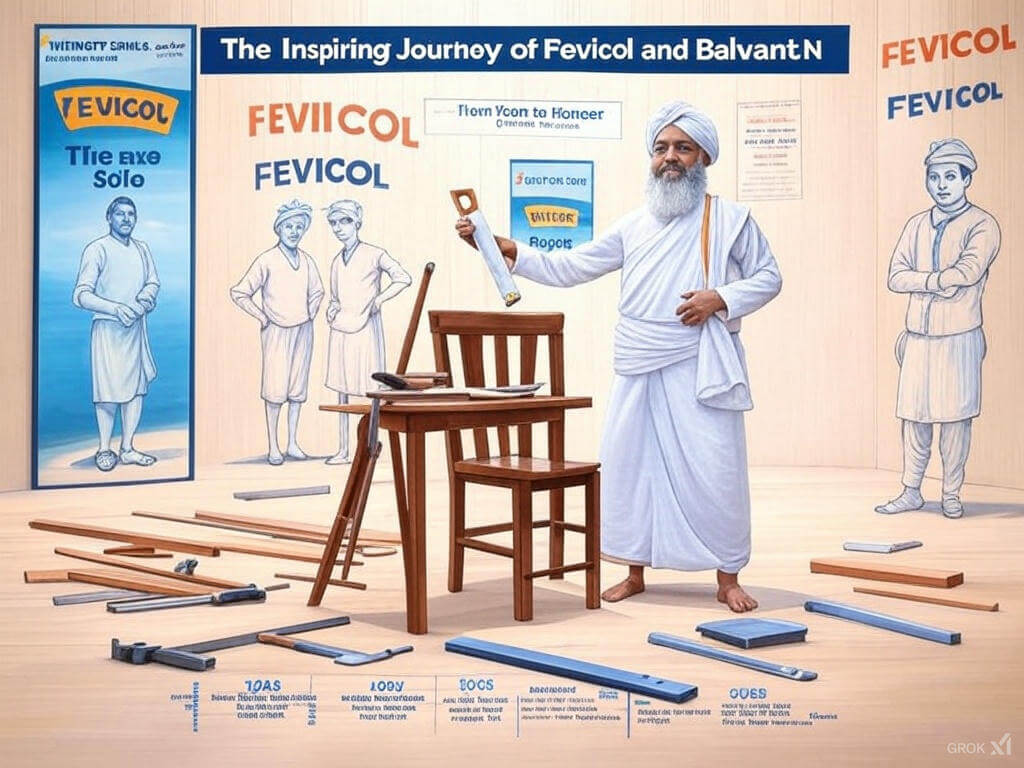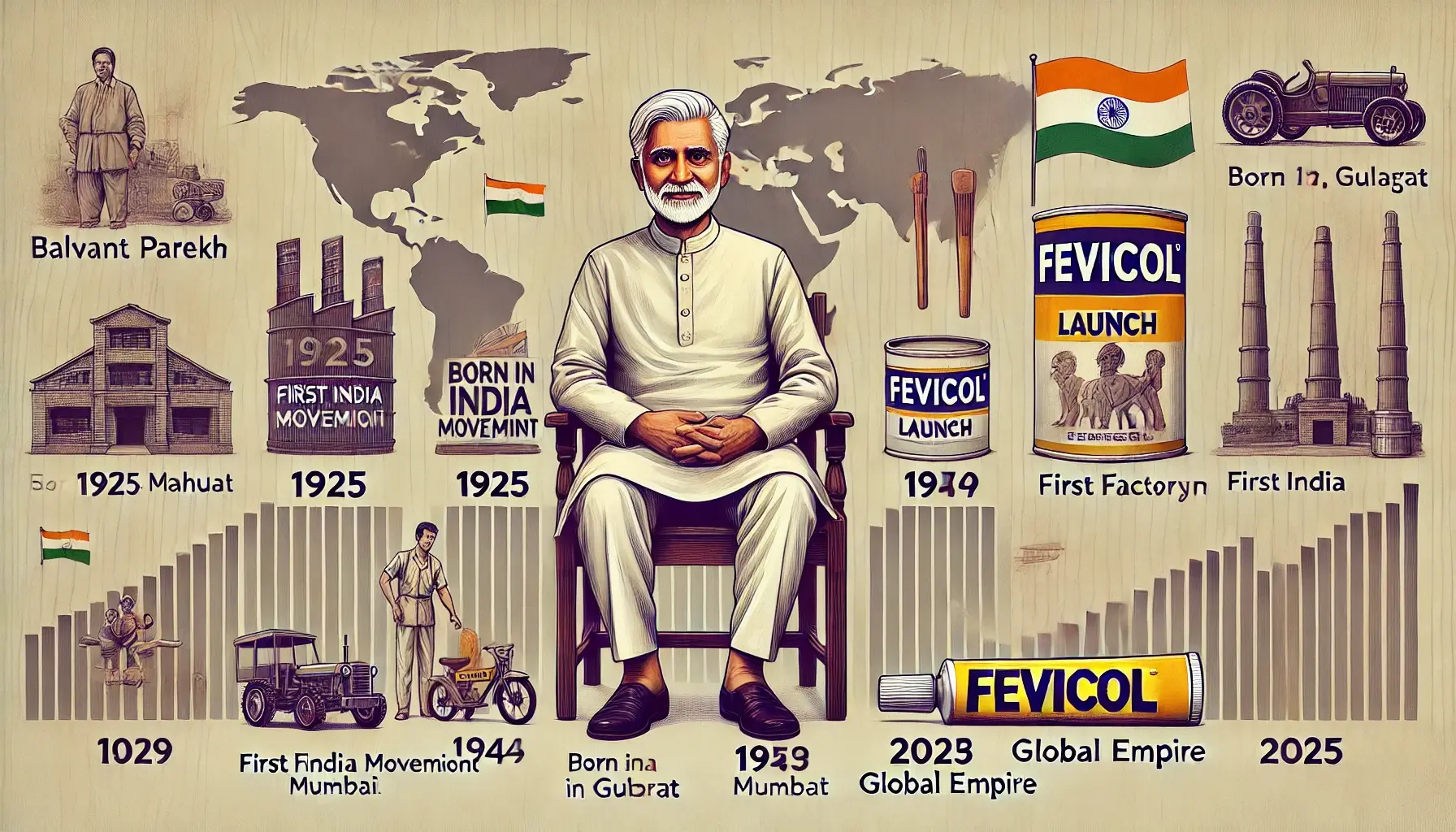The Inspiring Journey of Fevicol and Balvant Parekh
Introduction: A Legacy That Bonds India
In India, it’s hard to find a household that doesn’t rely on a Pidilite product. From Fevicol, the carpenter’s go-to adhesive, to Fevikwik, a favorite for quick fixes, Pidilite has woven itself into the fabric of daily life. But behind this iconic brand lies an inspiring tale of grit and innovation, led by Balvant Parekh—a man who rose from a peon to a pioneer. Today, Pidilite stands unrivaled in the adhesive industry, but its journey wasn’t always smooth. This post uncovers how Pidilite turned challenges into opportunities, winning hearts and dominating markets.

The Early Years: Balvant Parekh’s Humble Beginnings
Balvant Kalyanji Parekh was born in 1925 in Mahua, a small village in Gujarat. Inspired by his grandfather, a magistrate, he aspired to study law. After his initial education, he joined Mumbai’s Government Law College. However, the 1940s were turbulent years under British rule, with oppression fueling the fight for independence. When Mahatma Gandhi launched the Quit India Movement, Balvant abandoned his studies to join the cause, returning to his village as a freedom fighter.
A year later, he realized that a higher position could amplify his impact. Returning to Mumbai, he resumed his studies, married Kanta Ben, and took on odd jobs to support his growing family. Despite completing his law degree, he rejected a legal career, believing it demanded compromises against his ethics. Instead, he took a job as a peon in a wood trader’s office, marking the start of an unexpected journey.
Spotting the Opportunity: A Market Gap in Adhesives
Living in a wooden warehouse with his wife, Balvant faced financial hardship. Yet, this adversity sparked a revelation. Working in the wood trade, he noticed a critical gap: carpenters relied on glue, but options were limited. Imported adhesives were costly and inconsistent, while local alternatives—made from rice or flour—were weak. Traditional glues, derived from animal bones and collagen, were durable but smelly, time-consuming to prepare, and off-putting to vegetarians.
Balvant envisioned a solution: an affordable, easy-to-use, hygienic adhesive tailored for India’s woodworking needs. This idea became the cornerstone of his future empire.
Building the Foundation: From Peon to Pidilite
In the 1950s, Balvant partnered with an investor named Mohan, importing bicycles, betel nuts, chemicals, and dyes. The profits stabilized his finances, allowing his family to move into a modest flat in Mumbai’s Sion area. His breakthrough came through a partnership with Fedco, a German firm linked to Hoechst, a chemical giant. In 1954, Hoechst invited Balvant to Germany, where he observed their production of “Movicol”—a user-friendly wood glue.
Inspired, Balvant returned to India with a mission: create an Indian equivalent. With his brother Sunil, he established a small factory in Mumbai’s Jacob Circle, founding Parekh Dychem Industries. In 1959, they launched Fevicol—a synthetic adhesive inspired by Movicol but designed for India’s climate and budget. The company was later renamed Pidilite Industries, setting the stage for a revolution.

Overcoming Hurdles: Winning Trust and Innovating
Fevicol’s early days were tough. Carpenters, loyal to traditional glues, doubted its strength, while affluent customers favored imported brands. With limited funds, Pidilite couldn’t afford mass advertising. Balvant took a hands-on approach, visiting small shops and carpenters, offering free samples, and hosting workshops to demonstrate Fevicol’s superiority—its ease of use, lack of odor, and vegetarian-friendly formula.
Initial versions struggled with heat and non-wood surfaces like plastic or metal. Balvant invested in R&D, refining the product based on feedback. Variants like Fevicol MR (moisture-resistant) and Fevikwik (instant-bonding) expanded its versatility, turning skeptics into loyal users.
Marketing Mastery: Making Fevicol a Household Name
Pidilite’s marketing brilliance lies in its simplicity and relatability. Avoiding celebrity endorsements, Fevicol’s ads featured everyday people and humor—think the overcrowded bus or the elephant pulling a log. Taglines like “Dum Laga Ke Haisha” became cultural staples, showcasing the glue’s strength.
Counterfeit products posed a threat, but Pidilite fought back with unique packaging, QR codes, awareness campaigns, and legal action. The Fevicol Champions Club (FCC), launched in 2002, strengthened ties with carpenters through training and community-building, growing to over 40,000 members across 145 cities.
A Global Legacy: Balvant Parekh’s Enduring Impact
Balvant Parekh, dubbed the “Fevicol Man,” passed away on January 25, 2013, at 88. His sons, Madhukar and Ajay Parekh, carry forward his vision. Today, Pidilite products reach over 80 countries, with manufacturing hubs in the UAE, USA, Thailand, and more. Commanding over 70% of India’s adhesive market, the family’s net worth is $14.6 billion, ranking them 17th on Forbes India’s Rich List.
Conclusion: Lessons from a Bond That Lasts
Fevicol’s journey—from a peon’s dream to a global brand—teaches us the power of perseverance, innovation, and connection. Balvant Parekh didn’t just create glue; he built bridges between people, industries, and nations.
Types and Uses of Fevicol: A Versatile Adhesive
Fevicol isn’t just one product—it’s a range of adhesives designed for diverse needs. Here’s a breakdown of its main types and their uses:
-
- Fevicol SH (Synthetic Resin Adhesive):
-
- Use: Ideal for woodworking, especially furniture like chairs, tables, and cabinets.
-
- Features: Strong bonding, heat-resistant, and dries clear, making it a carpenter’s favorite.
-
- Fun Fact: Known as the “original Fevicol,” it’s behind the brand’s iconic ads showing unbreakable bonds.
-
- Fevicol SH (Synthetic Resin Adhesive):
-
- Fevicol MR (Moisture-Resistant):
-
- Use: Perfect for school projects, crafts, and light woodwork; popular among students and hobbyists.
-
- Features: Water-soluble when wet, non-toxic, and easy to clean, making it safe for kids.
-
- Why It Matters: Its affordability and versatility brought Fevicol into homes beyond workshops.
-
- Fevicol MR (Moisture-Resistant):
-
- Fevicol Marine:
-
- Use: Designed for wet environments, like boat repairs or outdoor furniture exposed to rain.
-
- Features: Waterproof and highly durable, resisting moisture and weathering.
-
- Surprising Use: It’s strong enough for industrial applications yet accessible for DIY enthusiasts.
-
- Fevicol Marine:
-
- Fevicol Speedx and Fevikwik:
-
- Use: Instant bonding for small repairs—think broken plastics, metals, or rubber items like shoes or toys.
-
- Features: Super-fast drying (seconds!), strong grip, and precise application.
-
- Everyday Impact: Fevikwik’s “one drop” slogan made it a go-to for quick fixes nationwide.
-
- Fevicol Speedx and Fevikwik:
These variants showcase Fevicol’s evolution from a woodworking glue to a multi-purpose adhesive, catering to carpenters, students, and households alike.
FAQs
1. Who founded Pidilite Industries?
Balvant Kalyanji Parekh, a former peon and freedom fighter, founded Pidilite Industries, turning it into a leading adhesive brand.
2. When was Fevicol first introduced?
Fevicol was launched in 1959 by Balvant Parekh under Parekh Dychem Industries, later renamed Pidilite Industries.
3. What sets Fevicol apart from other adhesives?
Fevicol is affordable, easy to apply, odorless, and vegetarian-friendly, outperforming traditional and imported glues.
4. How did Pidilite address counterfeit products?
Pidilite introduced unique packaging, QR codes, awareness campaigns, and pursued legal action against counterfeiters.
5. What is Pidilite’s market share in India?
Pidilite holds over 70% of India’s adhesive market, making it the undisputed leader.
📚 Also Read
- Top 21 amazing and useful websites 2025 Best in 2025
Top 21 amazing and Useful Websites 2025″ – You’ll be surprised to learn about these unique and helpful websites! From fun tools to productivity boosters - W3Schools: The Best Website for Free Online Web Tutorials 2025
Explore W3Schools, a leading platform offering free tutorials on HTML, CSS, JavaScript, PHP, Python, and more. - 4 Key Ways to Keep Visitors Coming Back to Your Blog (Ultimate Guide 2025)
Discover the top 4 strategies to keep visitors returning to your blog. Learn how to engage readers, increase blog traffic, and retain loyal followers with this comprehensive 2025 guide.
